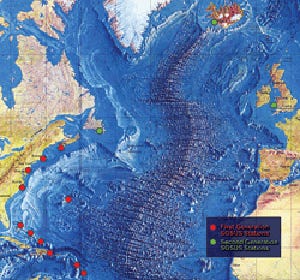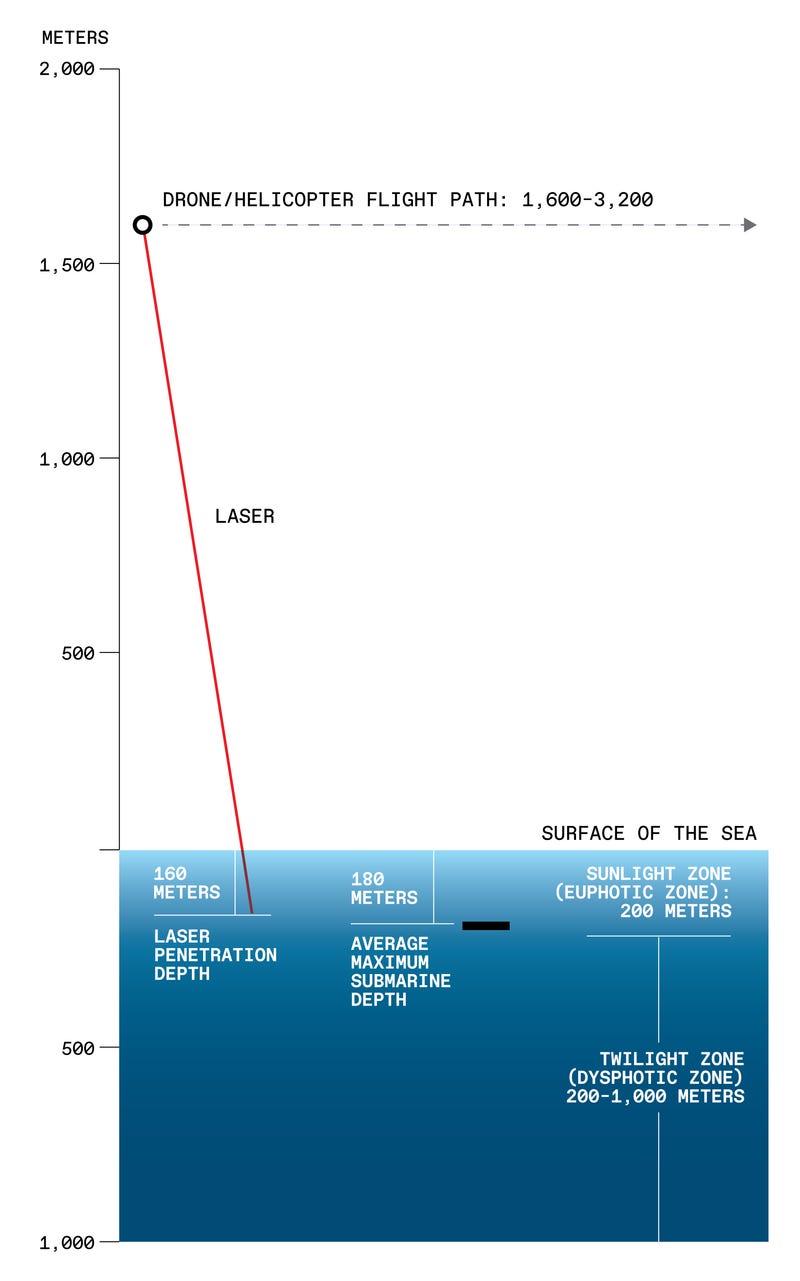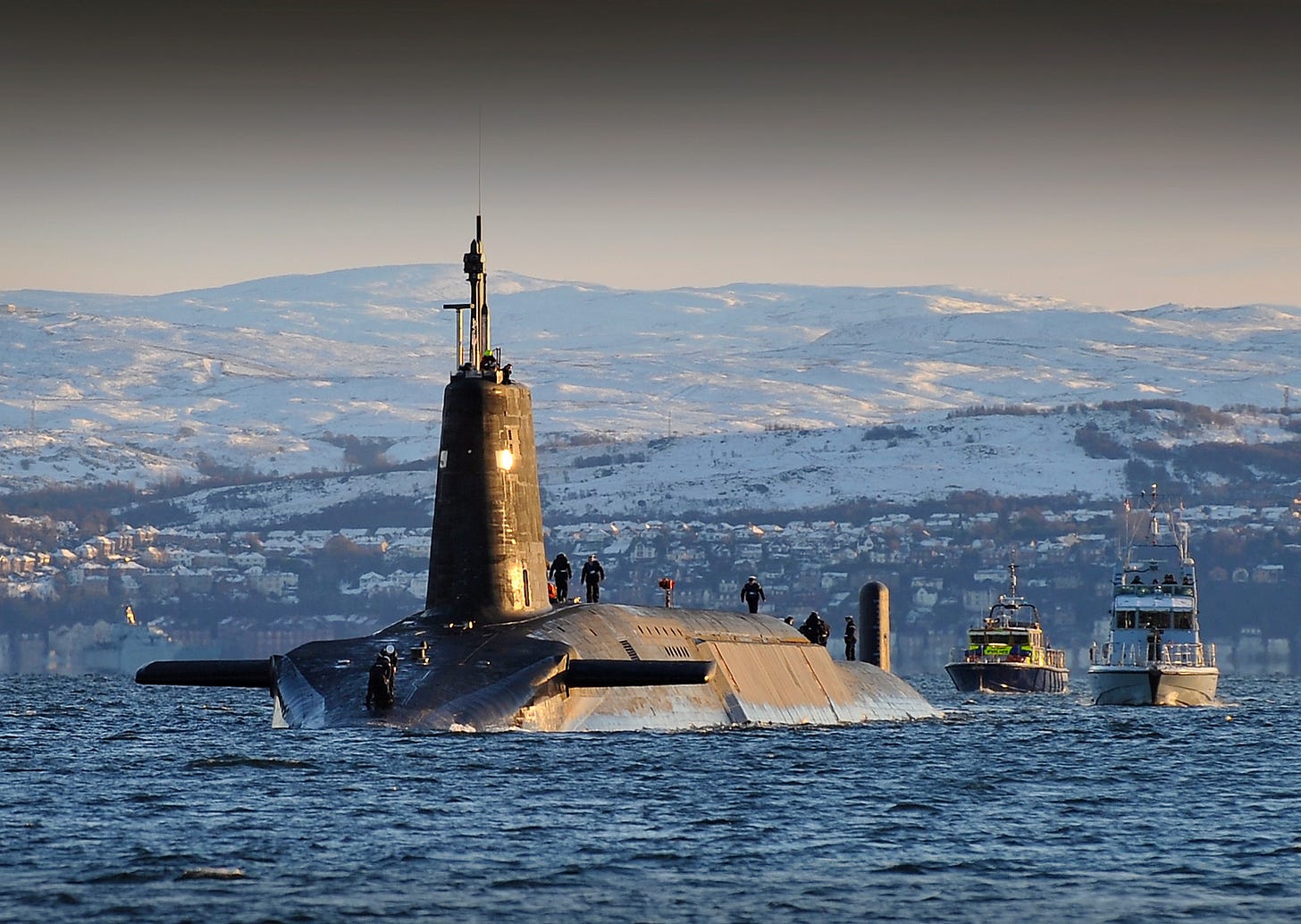Tracking the Untrackable?
Neutrino detectors, nuclear safeguards and the future of sea-based deterrence
Late last year, the U.S. Defense Advanced Research Projects Agency (DARPA) publicly announced its ambition to improve existing neutrino detectors. The goal is to develop a design that is “much lighter, enabling mobility and deployment of detector arrays for distributed sensing.” Neutrino detectors have been explored for monitoring nuclear reactors since the late 1970s, generating interest in their potential to enhance nuclear nonproliferation and arms control frameworks. This fascination has paralleled their use in civilian research, particularly following the 2015 Nobel Prize in Physics for the discovery of neutrino oscillations. DARPA’s pursuit of this technology thus presents an intriguing and complex dual-use dilemma.
As the primary U.S. agency for military research and development, DARPA has not disclosed the precise nature of the program. However, its stated aim is to significantly reduce the size of conventional designs, enabling the deployment of more discreet systems in shallow waters such as rivers and coastal zones. A key possibility is that such advancements could enhance the detection of nuclear-powered submarines. In other words, neutrino detection research may soon pose a serious threat to both nuclear-powered attack submarines (SSNs) and ballistic missile submarines (SSBNs), extending its implications beyond clandestine reactor sites on land.
This article examines the peaceful applications of neutrino detectors, their potential threat to nuclear-powered submarines, and pathways forward. While neutrino detectors hold significant promise for civilian research and nuclear nonproliferation, their impact on warfare will vary depending on geography and counter-adaptation measures. In the short term, these developments will have consequences primarily for China and Russia. However, if neutrino detection becomes widely accessible, sufficiently advanced to cover large areas, and integrated with multiple data streams to form a detect-chase-kill chain, it could reshape defense planning for India, France, and the AUKUS signatories as well.
How neutrino detection could enhance nuclear safeguards
Neutrinos are subatomic particles that exist in vast numbers but are notoriously difficult to detect. Nuclear reactors artificially produce specific quantities of these electrically neutral particles, which can pass through shielding and containment structures with ease. Cherenkov detectors, for instance, use water and photomultiplier tubes to measure neutrino collisions with hydrogen nuclei and the resulting radiation levels. Since the quantity and intensity of emitted neutrinos are directly tied to fission reactions, they allow for a relatively precise characterization of nuclear activity. However, due to neutrinos' low interaction cross section, detection has traditionally required large-scale detectors ranging from tons to kilotons - a problem for field applications. DARPA now seeks to leverage naturally occurring bodies of water to reduce detector size.

Nuclear activities can, of course, be monitored through numerous other mechanisms. The International Atomic Energy Agency (IAEA), the global authority overseeing nuclear safeguards, lists over a hundred such techniques. These methods track nuclear materials from spent fuel storage sites to routine inspections of power plants, ensuring that materials remain in place and maintain appropriate enrichment levels. However, barriers to inspections arise when actors seek to conceal undeclared activities or safeguard technological secrets.
North Korea and Australia illustrate these challenges. The DPRK withdrew from the IAEA in 1994 and declared in 2003 that it would no longer adhere to the Nuclear Non-Proliferation Treaty (NPT). Since then, it has developed an advanced nuclear weapons program, and could use its reactors to enrich materials for additional warheads. In contrast, Australia remains part of the NPT and the nuclear-weapon-free zone established by the Treaty of Rarotonga. However, under Pillar I of the AUKUS agreement, it plans to acquire nuclear-powered submarines (SSNs) from the UK and US. These submarines’ reactors, powered by highly enriched uranium, would be sealed before transfer to Australia—an approach designed to comply with NPT obligations but nonetheless controversial.
Political and physical conditions can complicate on-site IAEA inspections. North Korea is unlikely to allow them at all, while Australia may be reluctant to grant inspectors access to submarines containing sensitive technology. Additionally, shielding, submersion, and reactor power levels can tamper with reactor measurements, in addition to significant distances to the detector. Commonly used techniques, such as muon detection— previously applied to monitor fuel and warheads on SSBNs—would be too imprecise, and just like gamma ray detection, be of no use across several kilometers. Neutrino detection could address these challenges, theoretically enabling near-instantaneous measurement of nuclear materials at distances exceeding 100 meters, regardless of shielding. However, practical long-range monitoring remains out of reach for now.
The threat to SSNs and SSBNs
A capable neutrino detector would pose a threat not only to stationary nuclear reactors but also to those powering naval vessels. While surface ships are often intended to project force openly, detection presents a far greater risk to submarines. If SSBNs and SSNs could no longer evade tracking, it would force a fundamental reassessment of national defense procurement and strategy for several states.
Nuclear-powered submarines currently benefit from “superior speed, range, stealth, and endurance.” SSBNs, such as the UK’s Vanguard-class, are considered relatively secure, survivable, and non-escalatory compared to land-based ICBM silos or strategic bombers. Their deterrent value depends on remaining undetected and within range of their targets. Additionally, the long operational lifespan of their reactors—typically requiring refueling only once every 25 years—allows both SSBNs and SSNs to operate submerged for extended periods and at greater speeds than conventional submarines.

Unsurprisingly, interest in this technology remains high. Of the nine nuclear-armed states, only three have not developed SSBNs. India recently unveiled its second SSBN, the INS Arighaat, while the UK continues to rely exclusively on sea-based deterrence. The US and France also deploy most of their warheads on sea-launched ballistic missiles (SLBMs). AUKUS has set a precedent for non-nuclear weapon states acquiring fissile materials to operate SSNs, with Brazil voicing similar ambitions. Even Russia and China, traditionally land powers, have invested heavily in modernizing their nuclear-powered fleets. The emergence of effective and reliable neutrino detection could potentially disrupt these efforts, and reshape the strategic landscape.
Geographic and operational limits
However, the extent of this threat must be contextualized. Geography will play a crucial role, at least in the short term. The technology needs to mature in order to allow for the expansive coverage of vast and deep oceans. In the meantime, a more effective approach would be to place detectors with limited range in strategic locations, such as shallow waters, or near operating bases and chokepoints, i.e. what DARPA appears to be working on. During this early stage, the U.S., UK, France, and India will continue to benefit from free access to deep waters if and when the technology spreads, whereas China and Russia will remain relatively constrained by the GIUK Gap and the First Island Chain.
Threat assessments must also account for chase and kill capabilities. To illustrate this point, consider existing hydroacoustic sonar monitoring and satellite imagery analysis, which is already available through the Comprehensive Test Ban Treaty Organization’s (CTBTO) International Monitoring System and commercial vendors. While useful for tracking naval buildups and base modernizations, these open-source methods naturally suffer from procurement and analysis delays, and don’t come with sophisticated weaponry needed to pose a serious threat to military submarines. Yet, even advanced militaries face challenges in this regard. For example, Chinese SSBNs typically patrol the South China Sea under escort from attack submarines and with reinforcements nearby.
Defence planning and “Ocean Transparency”
Neutrino detectors are unlikely to become a silver bullet (or torpedo?) in submarine warfare. Historical precedents suggest that new detection technologies often prompt countermeasures rather than rendering submarines obsolete. For example, during the Cold War, Soviet submarines faced a constant threat from the U.S. Sound Surveillance System (SOSUS). In response, the Soviets adopted a bastion strategy, concentrating and defending their submarines in sanctuaries in near-home waters—an approach not dissimilar to China's today. Indeed, ironically, this prior adaptation to asymmetric detection capabilities may mean that their operations will change very little, while the technology and its military application is slowly being refined.

The novelty of this threat is first and foremost the particularity of the detection approach. Unlike traditional hydroacoustic and other methods such as synthetic aperture radar (SAR), neutrino detectors pose a specific threat to vessels using nuclear propulsion. SSBNs present a significant portion of those and bear immense strategic value. Defence planners conducting worst-case analyses will closely scrutinize both the necessity of developing this technology and its potential use against sea-based deterrents.

However, neutrino detectors will not suddenly turn the oceans transparent. They cannot detect conventional submarines, which are more numerous than nuclear-powered ones, nor will they necessarily replace existing detection methods for nuclear submarines. Instead, they will likely function as part of an extensive sensor network generating vast amounts of data. To interpret this influx effectively, reliable sorting algorithms must be developed, secured against electronic warfare, and supplied with sufficient energy. This interaction between various technologies is what defines contemporary debates on ocean transparency.
What are the next steps?
While neutrino detectors hold significant potential for scientific research and peaceful applications, their security implications must be considered. Here they share similarities with other emerging technologies, such as artificial intelligence in command and control systems, being a dual-use technology that is difficult to distinguish and defying a clear arms control verification mechanism. Additionally, variations in technological development and strategic impact among nuclear-armed states complicate the formation of a unified approach. For now, the prospect of a formal international agreement remains thus uncertain.
However, the possibility of informal code of conducts or behavioral arms control measures should not be dismissed. Even if neutrino detectors increase the vulnerability of SSBNs, this does not necessitate a fundamental shift in deterrence dynamics. Simply having the capability to locate an adversary’s nuclear forces does not automatically lead to their targeting.1 When Ukrainian forces attacked Russian early warning radars with drones, for instance, the U.S. discouraged further strikes, seeking to prevent misperceptions that could escalate into nuclear conflict. Similarly, absent an imminent first-strike scenario, there would arguably be no strategic rationale for deliberately targeting SSBNs.

Unilateral decisions could also shape states’ responses to neutrino detection technology. Some may choose to forgo its development for warfighting purposes, thereby avoiding costs while cultivating an image as a responsible stakeholder. Others might shift toward diesel-electric submarines, which would not necessarily increase vulnerability. Modern conventional submarines, particularly those equipped with air-independent propulsion systems—such as the German Type 212 or Sweden’s HMS Gotland—can rival SSNs in stealth. Though slower, they operate with near silence on battery power, remaining submerged for up to three weeks. Their lack of reactor cooling pumps reduces noise and thermal signatures, while their smaller hulls make them less detectable by sonar. Indeed, reports from various naval exercises (e.g. here and here) suggest that conventional submarines have, on occasion, outperformed their nuclear-powered counterparts.
Conclusion
Neutrino detection technology presents both opportunities and challenges for nuclear safeguards and security. While they enhance nuclear nonproliferation efforts by enabling the remote monitoring of undeclared reactor activity, their application in tracking nuclear-powered submarines could undermine strategic stability. Nations with restricted access to deep waters, such as China and Russia, will see conditions worsen, while others, including India, France, and AUKUS signatories, could see long-term consequences if neutrino detection becomes widely accessible and integrated into broader surveillance networks. This raises questions about the future role of SSNs and SSBNs in naval strategy.
Although a formal arms control framework remains uncertain, existing deterrence dynamics and behavioral norms could help manage security risks. At the same time, dismissing the technology's benefits for scientific research and nuclear nonproliferation would be shortsighted. As neutrino detection capabilities evolve, states must carefully balance its potential for enhancing global security with the risks it poses to current defense doctrines.
Ghost Fleet, a fictional exploration involving the use of an operational neutrino detector in warfare, also recognised this.




Super interessant. Thanks for sharing!